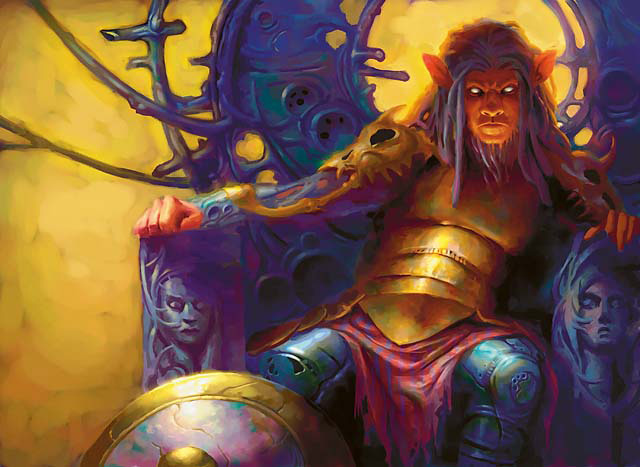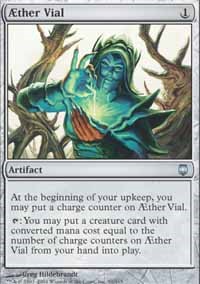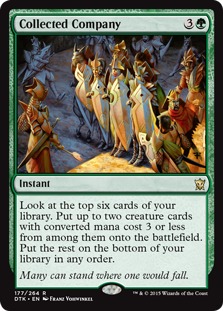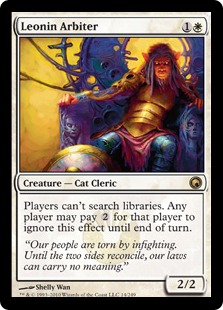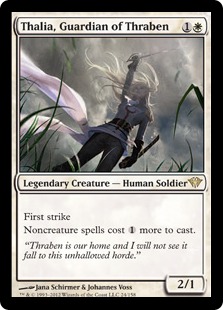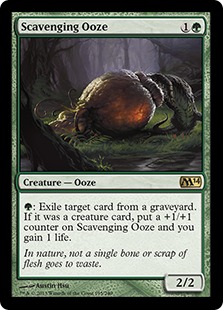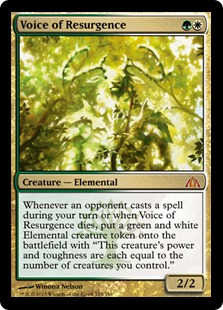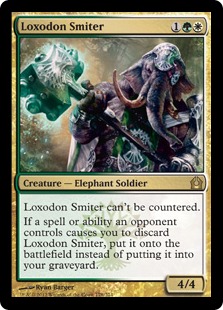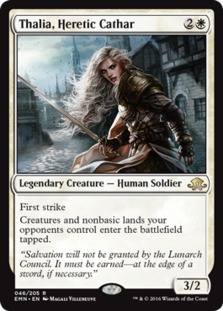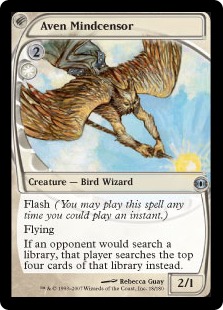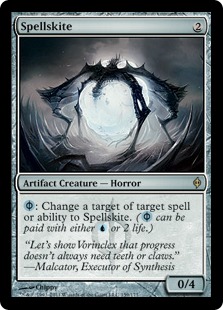I’ve been playing GW Hatebears for a long time. In fact, it was my very first modern deck. I recognized that the top tier Modern decks were dominated by greedy (and expensive!) mana bases. I didn’t want to drop a bunch of money on fetch lands or the other pricey pieces needed to build something like Jund (the best deck at the time). Instead, I decided to attack Modern’s greedy mana directly and came across the GW Hatebear archetype. When I finally brought it to my very first sanctioned modern tournament a few years ago, I split the Top 4 of a local Grand Prix Trial and took home a few hundred dollars worth of modern staples, ironically including my first Scalding Tarn.
As I built a collection and moved on to play Splinter Twin, I left Hatebears behind, dismissing it as a budget deck. Earlier this year I wrote about testing Modern for the upcoming PPTQ season. In the wake of the Splinter Twin ban, I was having trouble finding a deck I liked again.
At the time of that article, Eric Blanchet (a fellow Twin mage looking for a new home) was asking me what I thought about Hatebears. With the recent printing of Thalia, Heretic Cathar and Selfless Spirit he was interested in seeing if the deck could compete in Modern. I wouldn’t have picked it up again if it weren’t for his suggestion, but with my experience I figured I’d be able to help him with a build that would be worth testing. The two of us tested the archetype separately even though we discussed our thoughts and results along the way. We both ran the deck through PPTQ season and at GP Indianapolis, but we landed on pretty different builds.
Some of my choices are unconventional. I’ll discuss my build here, as well as the pros and cons of some typical card choices for the deck. For my current list, you can skip to the end, but I’m going to go over some of the tools GW has available.
Aether Vial
Let’s start with the topic bound to be the most controversial. Aether Vial is often considered the centerpiece of any strategy that it is in: Merfolk, Slivers, Legacy Death and Taxes. But I have chosen not to include this staple card.
Vial is an incredibly powerful card, to be sure, so let’s break it down. What is Vial good at?
- Tempo (Mana Production) – Vial produces a lot of mana in the middle turns of the game allowing you to deploy threats faster than your opponent. For a 1 mana investment, a turn 1 Vial produces an effective 10 mana by turn 5 if you can use it all the way up the curve from 1-drop to 4-drop.
- Mana Fixing – When you have a turn 1 Vial you can keep some sketchy hands. You don’t need to have the right color of mana to cast your creatures. Heck, you don’t need to have more than 1 land at all. The Vial will let you deploy threats even if you stumble on the color or quantity of lands.
- Evade Sweepers – Activating Vial on the opponent’s turn you can add threats to the board after a wrath and be ready to attack the next turn.
- Evade Counterspells – Vial lets you avoid interacting with your opponent on the stack, potentially stranding them with a hand full of useless counter magic.
- Abusing Sorcery Speed Effects at Instant Speed – Whenever you can break the rules of the game you can do some pretty degenerate things. Being able to deploy any creature at instant speed opens up a whole world of deckbuilding and strategic possibilities.
- Frees Mana to Be Used In Other Ways – Aether Vial lets you develop your board while using your mana to pay for abilities or activate abilities of utility lands. You can use Ghost Quarter or Tectonic Edge more freely, cycle Horizon Canopy or activate Gavony Township (if you play it).
- Ambush in Combat – The possibility of adding to the board at instant speed makes combat very difficult for your opponent. You can add a surprise blocker to eat one of their creatures in combat. But even if you don’t have a creature in hand, your opponent may not know that and the threat of it may be good enough to make your opponent think twice about how to attack.
- Flexibility – If you have multiple options it may not be obvious which 3-drop you want to play out. Normally, you’d have to choose want to cast from your hand before passing the turn. With Aether Vial, you don’t have to make that choice until your opponent’s turn if you don’t want to. The longer you can wait to react to your opponent the more optimally you’ll be able to deploy your hand.
And that’s just a partial list. This card is pretty powerful so why don’t I play it?
Even though Vial generates a mana advantage, I think it’s too slow for the format. Vial is at its best on turns 3-5, but Modern is so fast right now that on turn 3 you are often just trying not to die. For a GW deck to compete in modern, I think you really have to start on a turn one mana dork. Without that immediate acceleration it’s too easy to fall behind which is why I’m running some copies of Birds of Paradise as my additional turn 1 play.
A big draw to picking up this deck for me was to play Thalia, Heretic Cathar. The new Thalia can be devastating against a lot of opponents if played on turn 2. Playing additional mana dorks over the Vials maximizes the number of games where you’ll be able to play her a turn early. The same is true for Loxodon Smiter which can threaten to attack for 5 or more on turn 3. Getting a 3-drop down on turn 2 is one of the best openings the deck can have, and Vial just does not enable this line.
A lot of Vial’s strength is against blue decks that are packing counter spells and/or wraths. Take a look around at Modern and you won’t see many of either of these. The format is too hostile toward control decks already, so Vial doesn’t get a chance to shine. If Jeskai Nahiri were a Tier 1 deck or started seeing more play I would definitely take another look at Vial to improve that matchup.
Many GW builds don’t get a lot of additional value from playing their creatures at instant speed. Other than playing surprise blockers, most builds aren’t abusing enters the battlefield effects (except for adding an Arbiter in response to fetches). In my opinion, one of the biggest incentives to taking the deck in an Aether Vial direction is to play it as a package with Flickerwisp and Restoration Angel. Flickerwisp can do a lot of great things, but note that the value of x/1s goes down a lot if Abzan is popular due to Lingering Souls and potentially Liliana of the Last Hope.
Where I do think Vial shines is as a mana fixer and freeing your mana to activate utility lands and abilities. For a 2-color deck, you do lose a surprising number of games to your mana because of all the colorless lands or just getting your mana dorks bolted. A Vial can let your deck function when you stumble on mana. Importantly, it also lets you develop your board while using your lands to disrupt your opponent with Ghost Quarters or activate a Gavony Township.
Of Aether Vial’s many strengths, I think it’s only truly real ability in the current format is to fix the deck’s mana. The other benefits of Vial are either not needed or not impactful enough in the current format. If I’m looking to improve my mana, I’d rather just play more mana dorks.
If you do play Vial, I think the only reason to do so is to try to abuse Flickerwisp but the payoff just isn’t good enough for me to go in that direction. I think you’re better off looking at BW Eldrazi & Taxes which makes better use of the synergies with Flickerwisp.
Collected Company
When Company was first spoiled, GW Hatebears players were interested in testing it. It hasn’t become a staple of the archetype but I have loved it in my build. Without Vials, Company becomes a lot more viable since the only non-creature hits will typically be Path to Exile.
This is an alternative way to effect the board at instant speed. It also gives you some important selection when you trying to find the right hatebear for a particular matchup. Most importantly it gives GW a source of card advantage which the deck is sorely lacking. I was tuning this deck at a time when Jund was on the rise and Collected Company just wrecks Jund whereas Aether Vial is close to a dead card.
I do realize that it’s not a combo with Thalia, Guardian of Thraben. Thalia is often a lightning rod for removal so your opponent will usually get taxed to kill her and then you get to play Company on four mana anyway. In other matchups, Thalia is so important that if she is alive you are probably already winning. In the matchups where she isn’t needed you can usually play out your hand in a way that you Company first and play Thalia later. Other times you play Thalia on turn 2, you play a mana dork on turn 1 or 3 and you untap with 5 mana on turn 4 anyway. I have rarely had Company has my only play in hand and been unable to cast it because Thalia is in play.
It does affect sideboarding quite a bit. On the plus side, it allows you to play some 1-of creatures in the sideboard so that you can find them with Company. It also means you have to watch your creature count after sideboard when you want to add spells like Declaration of Stone, Engineered Explosives, Rest in Peace etc. As good as the card is, side boarding out some number of Company is right depending on what you are bringing in.
This is my preferred 4-drop, but other options are Restoration Angel and Wilt-Leaf Liege. Restoration Angel has been pretty good for me in the past, but it fits best with the Flickerwisp and Aether Vial plan rather than the Company plan. Wilt-Leaf would be nice to have in some matchups, but I haven’t tested with it much because of my preference for Company.
My only exception to the deckbuilding constraint that Company imposes is to play Linvala, Keeper of Silence. Linvala does a lot of work to improve two matchups that I had some trouble with in testing: Abzan Company and Bant Eldrazi. In my early testing, the majority of my loses were to the combo out of Abzan Company and to Eldrazi Displacer out of Eldrazi. Linvala completely shuts down both, plus the evasion is important in both matchups. She is definitely a flex slot though and can be changed with the metagame.
The Hatebears
Leonin Arbiter and Thalia, Guardian of Thraben are core cards for the strategy. The other 2-drops are somewhat flexible. I like at least two Scavenging Ooze and currently like 3 because of dredge. It’s weak in some combo matchups (Ad Nauseum, Tron) or when you have to race without interacting in combat (Infect, Affinity). Voice of Resurgence is great in fair creature matchups where the Elementals become big threats or against grindy decks like GBx that have trouble finding a 1-for-1 answer. It’s gotten worse as there are very few counter spells in the format and as GBx decks have moved to Path over Lightning Bolt. It has a similar downside to Scavenging Ooze in that when you are racing other linear decks it’s often just a 2/2 for two. I trimmed from 4 to 3 and could be convinced that the number should be even lower but I’m not sure what other two-drops I would want in that spot.
My last 2-drop is a pair of Qasali Pridemage. I had taken these out at one time, but they do just enough that I like having two as insurance against hard to deal with permanents. When your opponent plays Ensnaring Bridge, Blood Moon, or Worship it’s nice to know you have a couple of outs. Modern has enough targets overall and the exalted is surprising relevant so we save some sideboard slots by putting them in the main deck.
For 3-drops, I think Smiter is a must. In my build, I am trying to maximize on playing a 3-drop on turn 2. Thalia is often devastating, but as a legend I am hesitant to play more than 2. A turn 2 Smiter, especially off a Noble Hierarch, sets up a very fast clock so you can spend the next few turns disrupting your opponent. Aven Mindcensor is not a card everyone agrees on between number of copies or whether to play it main or in the sideboard. I really like having two to push the mana disruption aspect of the Hatebear strategy and the evasive body is often important.
I also like Aven Mindcensor’s cousin, Hushwing Gryff, as a singleton hedge that can be hit off of Collected Company. It neuters some of the biggest threats in Bant Eldrazi, Abzan Company and also shuts off Snapcaster Mage. These cards have seen a decline in play recently, so this is definitely a creature that could get replaced. Of note, it does stop Prized Amalgam returning from the graveyard out of Dredge.
The Sideboard
There’s nothing too special about my hate bear package. A few numbers get tweaked here and there but you usually see the same core creatures. The sideboard is where you really get to put your personal touch on the archetype based on the meta you expect to face.
I had ditched Spellskite. By playing Collected Company, I find that I rarely run out of threats. There’s no one creature in my deck that I need to protect in order to win the game and the deck is already very favorable against players trying to grind you out with spot removal. I’ve played plenty of long games against GBx and been able to outgrind them with Company and Horizon Canopy. Spellskite is always used defensively – specifically against Bogles and Infect. The Bogles matchup is so bad that I’ve just given up on it and hope to draw my Engineered Explosives. Spellskite would be worth it for Infect, but for now I’m trying to rely on spot removal and Thalia. Chalice is also a consideration for the Infect matchup.
I like to use a lot of my sideboard to shore up the tougher linear matchups – I have a lot of slots dedicated to Affinity and Dredge. The deck is already pretty strong and resilient to the open field that I want to keep my sideboard focused on what I know to be the harder matchups. For this reason, I could see adding some more Infect hate and would consider running Spellskite in the board again.
I thought my burn matchup would be favorable but I’ve actually taken a number of losses to it. A turn 1 Wild Nacatl actually makes things pretty tough because it can take a couple of turns to develop a board that can profitably block it. It turns out that a 1-mana 3/3 matches up well against 2-mana 2/2s. An early Smiter helps but when they get Path out of the sideboard even that isn’t always good enough. I think this, in combination with its uses against Infect and Bogles, make me want to add a Spellskite or two back into the sideboard. I prefer Spellskite to Kitchen Finks for this matchup because of its effectiveness against Wild Nacatl and as a way to consolidate sideboard slots for the other matchups.
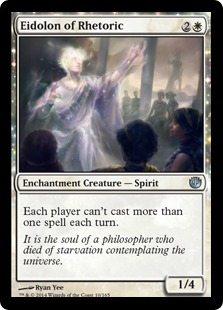
I really like having one Eidolon of Rhetoric. It blocks Wild Nacatl and slows burn down enough for you to race. It’s great against some of the more random combo matchups you may face like Storm, Ad Nauseum. It’s also great against Infect since they can never use multiple pump spells to combo kill you. They can’t really play any pump spells at all if you have mana open because they can’t protect themselves from a Path. Since you have a lot of flash threats you can play around the Eidolon restriction more than most opponents. It may get the cut to make room for Spellskite again though.
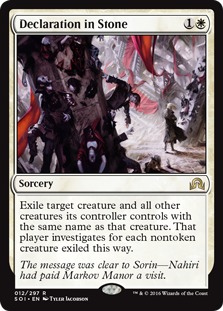
Declaration of Stone is some great tech that Eric suggested. When we are pinching our opponent on mana they often can’t afford to spend the mana or time cracking clues. Not to mention how great it feels when you Dec in Stone tokens from Lingering Souls, exile a board away from Dredge or kill your Affinity opponent’s best creature with a Stony Silence in play to shut off the Clue.
Decklist
If I were playing GW Hatebears this weekend, this is the list I’d register.
GW Hatebears, Nate Walker
Follow me on Twitter @thenatewalker.
Follow my Twitch channel: www.twitch.tv/n_walker. I stream a lot of limited, some standard/modern.
Or reach me in the comments below!
